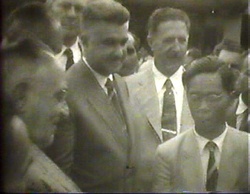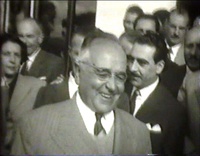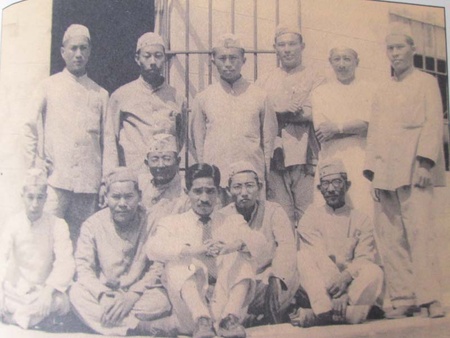By chance, an old film from 61 years ago came into my hands. It was delivered to me a few years after my father passed away by a friend to whom I had entrusted some antiques before he passed away.
I was astonished by the unexpected footage. It was documentary footage of the colony development project that my father, who had quit his job as a dental technician and moved to Paraná, planned with the state government in 1948. As it was made of old-style 35mm celluloid film and was prone to burning, we decided to have the Cinemateca Brasileira store it, but even the executives there were amazed when they saw the footage. It included scenes of the development project of the Dourados colony in Paraná, to which my father had devoted his life, as well as various news clips that were shown in movie theaters at the time.
One of the most eye-catching events was the inauguration ceremony of President Getulio Vargas in 1952. The excitement of the crowd reflected the political vigor of the time. I was also interested in the event and footage of an agricultural product exhibition organized by Japanese immigrants. The footage shows São Paulo State Governor Adémar de Barros disembarking from a helicopter, and local agricultural producers, that is, Japanese immigrants, coming to welcome him. He is greeted by many leaders of the Japanese Association, and children dressed in kimonos present bouquets to the governor.
I was curious and decided to personally look into the background of these news videos. There were some points that were unclear, but the following is what I found out through my research.
* * *
After the end of the Pacific War, a terrorist act by the winners, who refused to believe that Japan had lost the war, killed 23 losers and injured 147. 155 people, including leaders of the Shindo Renmei, the winners, who were involved in this incident, were imprisoned on Anchieta Island, located between Rio and Santos.
Around that time in Brazil, the Vargas dictatorship (1930-45) came to an end and a new constitution was enacted under the Dutra administration. In 1947, free elections were held in which women were given the right to vote for the first time, and Adhemar de Barros, who had been appointed governor under the dictatorship, was elected as governor of the state of São Paulo.
Notably, as part of his election campaign, Barros promised the release of the Shindo Renmei leaders who were imprisoned on Anchieta Island, of which 81 were sentenced to be deported from Brazil, but this was never carried out and almost all of them were released in 1948.
In 1950, Barros brought out former dictator Vargas (PTB), who had been in seclusion in the state of Rio Grande do Sul, and supported him to become the next presidential candidate. Barros promised Vargas the position of the next presidential candidate in return for his election, and launched a fierce election campaign in Brazil. As a result, Vargas won the presidency, defeating the ruling party's Dutra and the then-Air Force General Eduardo Gomes (UDN), who was backed by the United States.
And when Adhemar de Barros' term as governor of the state of São Paulo (1947-51) ended, he succeeded in getting a little-known engineer, Lucas Garcés from the University of São Paulo, named as his successor as governor through the reorganized PSP party, and began campaigning for the next presidential election.
However, Vargas, who Barros had promoted to the presidency, was anti-American and not good at working in cooperation with Congress. As a result, he was cornered by the stormy and eloquent Congressman Carlos Lacerda (former governor of Rio de Janeiro), and after it was revealed that Vargas' security guards were involved in an assassination attempt on Lacerda, he committed suicide on August 24, 1954.
As a result, Adhemar de Barros' ambitions also disappeared. I was 10 years old at the time, but I still remember it well. As an aside, the will left by Vargas is still a famous historical document.
* * *

Vargas, Garces and Adhemar, attempting to ease the winner/loser problem in the Japanese community, in Campos do Jordão, 1952.
The intriguing footage I found on my father's old film was taken during the second term of Vargas' administration, and was recorded in the Japanese community, where the issue of winners and losers was still rife. The agricultural product exhibition was planned as part of a plan to resolve the issues of the Shindo Rengo, the extremist winners group that was causing trouble in Brazil. By inviting the new president and the former and new governors of the state of São Paulo, leaders of the Japanese community sought to stabilize the Japanese community. This "winners and losers" issue, which had claimed so many lives, was alleviated through the efforts of many politicians and Japanese community leaders.
Later, in 1954, the Japan-Brazil Cultural Association and the Japan-Brazil Cultural Federation were established to unite all Japanese people in Brazil. In 1958, Prince and Princess Mikasa of the Japanese Imperial Family visited Brazil to commemorate the 50th anniversary of immigration. The ceremony was held successfully and with great splendor. It could be said that the Japanese community had finally returned to normal around this time. 13 years had passed since the end of the war.
The following year, in 1959, Prime Minister Nobusuke Kishi (grandfather of the current Prime Minister Abe) visited Rio and the Ishikawajima-Harima Shipyard was built in Rio. In addition, large-scale projects such as the construction of the Usiminas Steelworks were realized in the state of Minas Gerais. In this way, the Japanese community actively and proudly participated in the development of Brazil.
Looking back at this old video, it seems like there were more big-name politicians around at the time than there are now. Whatever their methods, some of the most representative figures would be Vargas (dictator), Lacerda (Brazil's greatest orator), Adhemar de Barros, Luiz Carlos, Prestes (communist), Kubitschek (builder of Brasilia), and Janio. Since the military dictatorship that followed the military coup in 1964, the trend has been "cut once the seeds sprout," and it seems like there are fewer and fewer big-name politicians among the new generation.
*This article is an updated version of the one published in the São Paulo Shimbun's "Readers' Room" column and introduced in "An Encounter That Was So Far Away."
© 2013 Hidemitsu Miyamura













